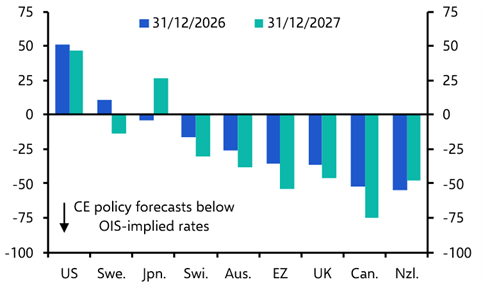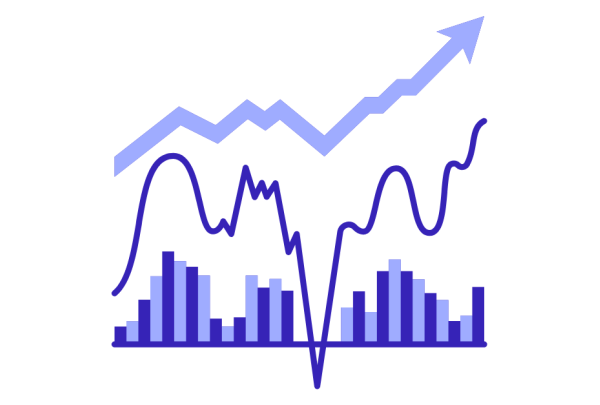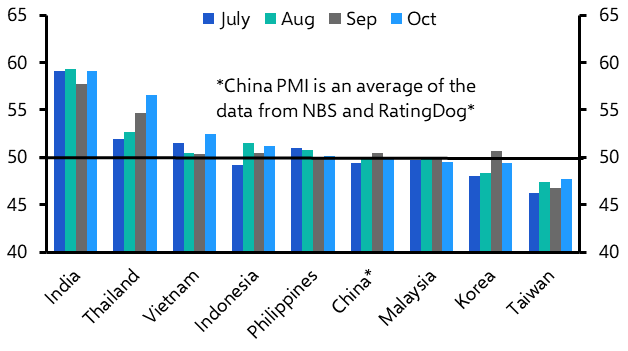Of the many questions we received during a series of webinars that we held late last month, the most common was whether the Coronavirus shock would be inflationary or disinflationary. The answer depends in part on the timeframe under consideration.
Over the next month or so, while economies are in lockdown, for many parts of the CPI basket the shock will be neither inflationary or deflationary. After all, with large swathes of the economy shut down, it is impossible to purchase many goods and services. Against this backdrop, the concept of inflation becomes irrelevant.
Beyond the very short term, there’s a lively debate among economists about the effects on inflation. The disruption has affected both the supply- and the demand-side of the economy. In theory, the former is inflationary (since the ability to supply goods and services is constrained) while the latter is deflationary (since demand for goods and services is diminished). The aggregate effect on inflation should therefore depend on how these two forces balance out.
We are already starting to see evidence that supply disruption is causing the price of some goods to rise. This is particularly true of food. Prices of some components used in manufacturing chains may also increase.
But the upward pressure on inflation coming from these items is likely to be more than offset by the downward pressure coming from other items. Most importantly, the collapse in oil prices will pull down fuel and energy prices in most economies over the coming months. If oil levels out at around $25pb, we estimate that the drop in prices will knock around 1.5%-pts off headline inflation in advanced economies by the end of Q2.
Of course, swings in commodity prices tend to have a transitory effect on inflation. Lower oil prices will pull down inflation over the next 6-12 months but, all other things being equal, the drag will unwind by this time next year. In contrast, disinflationary pressures caused by a more fundamental weakening of demand can have a longer-lasting impact.
It’s worth stressing that, in the same way that a flatter Phillips Curve helped to contain a build-up in core inflation pressures during the period of labour market tightening over the past couple of years, so it will help to limit the build-up of deflationary pressures as demand now weakens and unemployment spikes. Over the past fifteen years we’ve been through a credit-led boom, a housing-led bust, a recovery punctuated by the euro-zone debt crisis and, finally, a short burst in growth fuelled by tax cuts in the US. Throughout that period core inflation in advanced economies has been range-bound between 1% and 2%. Underlying inflation in the developed world has become remarkably steady.
In our view, the weakening of demand caused by the impending recession in the advanced economies will weigh on pull down core inflation, but by much less than the overall drop in the headline rate (which will be dragged down by lower commodity prices). Over 2020 as a whole, we’ve pushed down our forecasts for headline inflation in advanced economies from 1.6% to 0.3%, and core inflation down from 1.6% to 1.2%.
The upshot is that, while the scale varies from country to country, in most of the developed world the economic shock caused by the virus will tend to depress inflation over the next couple of years.
What about the inflation outlook beyond the next 2-3 years? The view priced into markets is that the low-inflation era will continue long into the future. That’s likely in the case of countries with monetary arrangements that tend to embed deflationary pressures (notably the euro-zone periphery). But for other countries it’s conceivable that the virus could mark the beginning of the end of the low-inflation era. After all, the recovery will be juiced by policy stimulus that is many times larger than was implemented in the wake of the global financial crisis - but without the disinflationary forces exerted by a weak banking system.
More fundamentally, it’s possible that some governments may start to view inflation as a way of reducing the burden of debt accumulated as a result of the current crisis. Of course, this would require a wholesale change to the mandate given to central banks. What’s more, as Japan’s experience demonstrates, any such move would have to overcome significant disinflationary pressures that have become entrenched over the past thirty years. But economic shocks have a way of reshaping the status quo in ways that are difficult to conceive of at the time. As the dust settles on the crisis, we may find it challenging our assumptions about the long run outlook for inflation.
In case you missed it:
• Our commodities team assess what Saudi-led output cuts might mean for oil prices.
• Our Global Economist, Simon MacAdam, has developed a useful tool that allows clients to model the economic impact of government shutdowns. It has proven to be extremely popular. You can download it here.
• Our Chief US Economist, Paul Ashworth, looks at the causes and consequences of the huge expansion of the Fed’s balance sheet.




